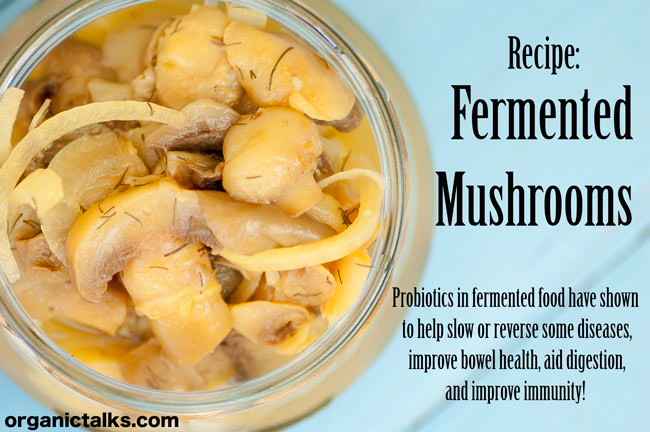Fermented mushrooms
Photo: Stanka Vukelić
Fermented mushrooms
This recipe has already been published as part of the Zucchini Spaghetti with Creamy Mushroom Sauce recipe. Because of the excellent taste and food value you get from the process of fermentation, I’ve decided to re-publish it again – independently.
Fermented mushrooms can be used in salads, raw sauces, or as a great addition to raw sandwiches. In this recipe, we use champignons, but you can of course use other mushrooms of your choice as well.
On mushrooms:
Did you know, that mushrooms, much like our skin, transform ultraviolet light from the sun into Vitamin D and continue to do so even after they have been harvested?
Vitamin D deficiency is common in the northern regions, especially during winter. Mushrooms exposed to the sun can provide as much vitamin D as a health supplement. For that, take the fungi out of their wrapping and leave them outside for half an hour before eating.
The health benefits of mushrooms combined with the probiotic properties of fermentation give us a powerful homemade superfood.
On fermentation:
There are several great reasons to start making and eating fermented foods. Eating fermented foods will introduce beneficial bacteria into your digestive system.
Probiotics in fermented food have shown to help slow or reverse some diseases, improve bowel health, aid digestion, and improve immunity! Gut bacteria and enough digestive enzymes help you absorb food better.
Preparing fermented mushrooms –
(Thanks to Mirri Maine for the tip!)
Ingredients:
17 oz (1/2 kg) of mushrooms
1 teaspoon of sea salt
2 teaspoons of dill
1 fresh-squeezed lemon
16 -32 oz (1/2 – 1 l) of water
1 onion (size you like)
Methods/steps-
1. Chop mushrooms.
2. Dissolve sea salt in water.
3. Put ingredients in a mason jar ( I use a 54 oz (1.6 l jar)) or other vessel. You must leave two-inches of room at the top of the container for expansion inside the jar; otherwise the mushrooms will expand and can overflow.
4. Make sure the mushrooms are covered with water. If needed, add more water.
5. Seal the jar and cover everything with a towel. Allow this to ferment on your counter for seven days.
6. After 7 days, place the finished mushrooms in the refrigerator, or use it. It will last at least 9 months or longer in the fridge.
Options: Place one of the larger outer leaves of a cabbage over the surface of the sliced mushrooms. This will help keep the mushrooms stay submerged in the water.
This post is shared on “Plant-Based Potluck Party!”
Please let us know what you think, and leave a comment below! We usually post one new recipe per week, so don’t forget to follow us on Google+, Twitter, or via RSS feed, or by simply subscribing to our newsletter at the end of this page!
organictalks.com




I like this idea and recipe, sounds like it is real good, thanks for the recipe! wizardQi
Thanks Robert – they are really good!
I’ve looked at several fermented mushrooms recipes and most seem to have whey in them. Thanks so much for this report, I’ll definitely be trying them soon!
You’ll be surprised – they are just excellent!
I’m wondering if fermentation might also increase the availability / absorption of the Vitamin D in mushrooms that have been placed in sunlight? I have seen studies that show fermentation dramatically increases absorption of other nutrients such as iron so it seems like it could be possible.
It does increase. I have also read several studies on this subject. We also had one article here on our site about Vitamin D multiplying in mushrooms. Thanks for bringing this up!
Hi Alen,
I love using probiotics and I am a huge proponent of mushrooms for health and healing so I am delighted that you shared this fermented mushroom recipe with us at the Plant-based Potluck Party link up.
I am pinning, tweeting and sharing this important post! All the best, Deborah
Thank you! It’s always great to collaborate with you!
– Stanka
Awesome! LOVE this idea of fermenting mushrooms!!!!! Visiting from the Pot Luck Linky!
Your blog doesn’t mention what kind of mushrooms. Can I assume domestic? Most wild edible mushrooms require cooking in order to make them safe for consumption. Does Fermentation render, for instance, Morels, Oysters, Chicken or Hens safe without cooking?
I am surprised that your brine is only at .5% salt. Is this sufficient to promote lactic fermentation? In all my sources the concentrations are 3-5% salt. Thanks for your answer.